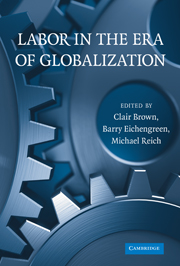Book contents
- Frontmatter
- Contents
- Tables and Figures
- List of Authors and Editors
- Introduction: Labor in the Era of Globalization
- PART ONE POLITICAL ECONOMY AND LABOR MARKET INSTITUTIONS
- 1 Institutions and Wages in Post–World War II America
- 2 American Exceptionalism and Comparative Political Economy
- 3 Finance and Labor: Perspectives on Risk, Inequality, and Democracy
- PART TWO INSTITUTIONS AND FIRM AND WORKER BEHAVIOR
- PART THREE CONTEMPORARY LABOR–MANAGEMENT RELATIONS
- PART FOUR PUBLIC POLICY AND U.S. LABOR-MARKET STRUCTURE
- Index
- References
1 - Institutions and Wages in Post–World War II America
Published online by Cambridge University Press: 05 June 2012
- Frontmatter
- Contents
- Tables and Figures
- List of Authors and Editors
- Introduction: Labor in the Era of Globalization
- PART ONE POLITICAL ECONOMY AND LABOR MARKET INSTITUTIONS
- 1 Institutions and Wages in Post–World War II America
- 2 American Exceptionalism and Comparative Political Economy
- 3 Finance and Labor: Perspectives on Risk, Inequality, and Democracy
- PART TWO INSTITUTIONS AND FIRM AND WORKER BEHAVIOR
- PART THREE CONTEMPORARY LABOR–MANAGEMENT RELATIONS
- PART FOUR PUBLIC POLICY AND U.S. LABOR-MARKET STRUCTURE
- Index
- References
Summary
A rising tide lifts all the boats.
John F. Kennedy, October 15, 1960Simultaneous and identical actions of United States Steel and other leading steel corporations, increasing steel prices by some 6 dollars a ton, constitute a wholly unjustifiable and irresponsible defiance of the public interest.
John F. Kennedy, April 11, 1962INTRODUCTION
This chapter was written for a particularly lovely occasion. One of the authors began his teaching career in the Berkeley economics department in 1967. For someone raised and educated on the East Coast, Berkeley was a lot to absorb: no winters, supermarket vegetables looking like they were grown in the Garden of Eden, a campus constantly going up in flames – usually figuratively but sometimes literally. The transition was made much easier by a welcoming faculty, with Lloyd Ulman at the head of the line. Lloyd took the time to explain how to negotiate the University of California system and constantly offered support – always moral, financial when it was needed. We appreciated being part of this occasion where we could return some of that goodwill.
In what follows, we deviate somewhat from the conference theme of new labor-market institutions. We focus instead on old labor-market institutions and their impact on the U.S. “Golden Age” of 1947–1973. A central feature of that Golden Age was mass upward mobility: individuals saw sharply rising incomes through much of their career and each successive generation was living better than the last.
- Type
- Chapter
- Information
- Labor in the Era of Globalization , pp. 15 - 50Publisher: Cambridge University PressPrint publication year: 2009
References
- 4
- Cited by

